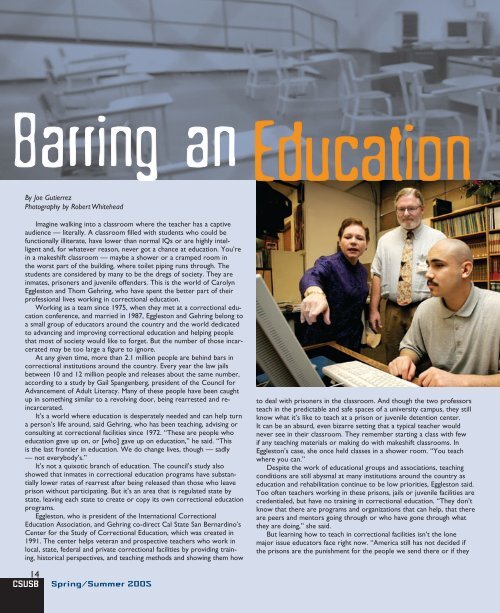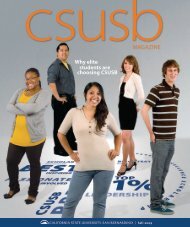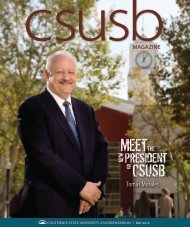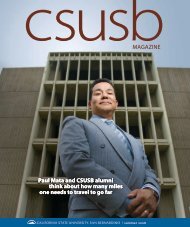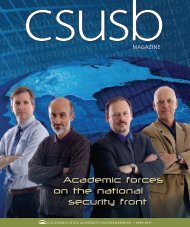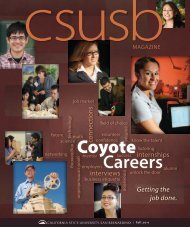CalMagSpr05 ind.indd - CSUSB Magazine - California State ...
CalMagSpr05 ind.indd - CSUSB Magazine - California State ...
CalMagSpr05 ind.indd - CSUSB Magazine - California State ...
- TAGS
- csusb
- magazine.csusb.edu
Create successful ePaper yourself
Turn your PDF publications into a flip-book with our unique Google optimized e-Paper software.
By Joe Gutierrez<br />
Photography by Robert Whitehead<br />
Imagine walking into a classroom where the teacher has a captive<br />
audience — literally. A classroom filled with students who could be<br />
functionally illiterate, have lower than normal IQs or are highly intelligent<br />
and, for whatever reason, never got a chance at education. You’re<br />
in a makeshift classroom — maybe a shower or a cramped room in<br />
the worst part of the building, where toilet piping runs through. The<br />
students are considered by many to be the dregs of society. They are<br />
inmates, prisoners and juvenile offenders. This is the world of Carolyn<br />
Eggleston and Thom Gehring, who have spent the better part of their<br />
professional lives working in correctional education.<br />
Working as a team since 1975, when they met at a correctional education<br />
conference, and married in 1987, Eggleston and Gehring belong to<br />
a small group of educators around the country and the world dedicated<br />
to advancing and improving correctional education and helping people<br />
that most of society would like to forget. But the number of those incarcerated<br />
may be too large a figure to ignore.<br />
At any given time, more than 2.1 million people are beh<strong>ind</strong> bars in<br />
correctional institutions around the country. Every year the law jails<br />
between 10 and 12 million people and releases about the same number,<br />
according to a study by Gail Spangenberg, president of the Council for<br />
Advancement of Adult Literacy. Many of these people have been caught<br />
up in something similar to a revolving door, being rearrested and reincarcerated.<br />
It’s a world where education is desperately needed and can help turn<br />
a person’s life around, said Gehring, who has been teaching, advising or<br />
consulting at correctional facilities since 1972. “These are people who<br />
education gave up on, or [who] gave up on education,” he said. “This<br />
is the last frontier in education. We do change lives, though — sadly<br />
— not everybody’s.”<br />
It’s not a quixotic branch of education. The council’s study also<br />
showed that inmates in correctional education programs have substantially<br />
lower rates of rearrest after being released than those who leave<br />
prison without participating. But it’s an area that is regulated state by<br />
state, leaving each state to create or copy its own correctional education<br />
programs.<br />
Eggleston, who is president of the International Correctional<br />
Education Association, and Gehring co-direct Cal <strong>State</strong> San Bernardino’s<br />
Center for the Study of Correctional Education, which was created in<br />
1991. The center helps veteran and prospective teachers who work in<br />
local, state, federal and private correctional facilities by providing training,<br />
historical perspectives, and teaching methods and showing them how<br />
14<br />
<strong>CSUSB</strong> Spring/Summer 2005<br />
to deal with prisoners in the classroom. And though the two professors<br />
teach in the predictable and safe spaces of a university campus, they still<br />
know what it’s like to teach at a prison or juvenile detention center.<br />
It can be an absurd, even bizarre setting that a typical teacher would<br />
never see in their classroom. They remember starting a class with few<br />
if any teaching materials or making do with makeshift classrooms. In<br />
Eggleston’s case, she once held classes in a shower room. “You teach<br />
where you can.”<br />
Despite the work of educational groups and associations, teaching<br />
conditions are still abysmal at many institutions around the country as<br />
education and rehabilitation continue to be low priorities, Eggleston said.<br />
Too often teachers working in these prisons, jails or juvenile facilities are<br />
credentialed, but have no training in correctional education. “They don’t<br />
know that there are programs and organizations that can help, that there<br />
are peers and mentors going through or who have gone through what<br />
they are doing,” she said.<br />
But learning how to teach in correctional facilities isn’t the lone<br />
major issue educators face right now. “America still has not decided if<br />
the prisons are the punishment for the people we send there or if they


